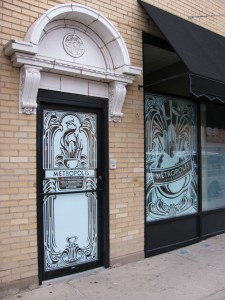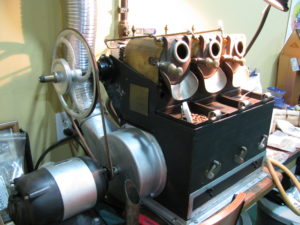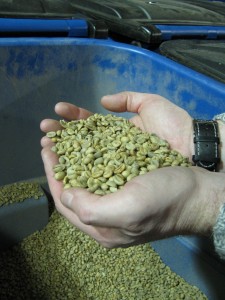- December 15th, 2010
- 1 Comment
 A wise man once said “the times they are a-changin’.” Sure, he meant the greater social structure of America and the world at large, but I thought I’d marginalize his saying by introducing our new coffee mongers: Metropolis.
A wise man once said “the times they are a-changin’.” Sure, he meant the greater social structure of America and the world at large, but I thought I’d marginalize his saying by introducing our new coffee mongers: Metropolis.
As everyone knows, coffee is pivotal to the brunch experience, some would say a necessity to anything before 11am. We needed a smaller roaster, a place locally situated here in Chicago only. We were in need of a change. The problem is that we are a needy bunch; our new roasters had to be local, big enough to dole out the copious amounts of beans we go through, be able to supply and repair our machines, have similar business ideals, and be cool enough to let us feature smaller local roasters every so often too. Boy did we find one.
Great people, infinitely nice, and extremely knowledgeable. Before we signed anything they invited us to poke around their roasting site with one of the owners, Tony. Our first visit was eye opening; their passion was palpable: from the time and love they put into the regular roasts, to how OCD they are about new beans. They showed us their World War II era coffee roasters, their fancy bag sorter, met nearly all of their amiable staff, had a cupping, and talked shop.
After a quick show around the roasting room they led us into the cupping room. It is here that they teach new clients latte art and brew form, pick their next line of coffee, and the proper beans for their regular lines. On one side, they have a beautiful relic of a machine that roasts small lots of beans for tasting – because as everyone knows, you never buy without a taste. On the same wall, small packages litter the counter – hand-packed sample bags from the far reaches of the coffee making world, the edges of tree coated mountains. On the other side of the ‘cupping room’ sits every form of brewing imaginable: drip, pour-overs, a slick espresso machine, vacuum brewers, a french press or two, unknown shapes of glass, stainless steel, and filters. Floating in the middle of the room is a reused metal table covered with tiny plastic containers with masking tape placed on the lids, origins and roasts scrawled atop in permanent marker. A veritable smorgasbord of coffee aromas and flavors pepper the its edges in small glass cups waiting to be brewed.
 On the far side of the room there is a massive window facing the two roasters Metro uses. The roasting machines are hulking masses of pig iron placed forward near the sound-proof glass where the cupping, break room, and offices are – a low rumble is more felt than heard. Samples of the darkening beans are checked with what looks like a broom handle stuck in the front of a furnace; the skilled roasters are looking for color, smell, sound, size. They listen to the beans over the sound of hip-hop, indie, and classic rock pushing it’s way across the open room, the mechanical noise of the machines themselves, and the roaring 1,200 degree ‘afterburners’ – blowers that disintegrate all the particulate matter. Kitty corner to the roasters, the labeling and bagging is done in machine gun succession – slapping stickers and sorting them in a home-made shelving system made from rebar and plywood, pouring in the beans, then weighing the multitude of bags. Late in the afternoon, while we were there the first time, the area had mellowed to a hum of movement and clean up filled the gaps between the last count of bags.
On the far side of the room there is a massive window facing the two roasters Metro uses. The roasting machines are hulking masses of pig iron placed forward near the sound-proof glass where the cupping, break room, and offices are – a low rumble is more felt than heard. Samples of the darkening beans are checked with what looks like a broom handle stuck in the front of a furnace; the skilled roasters are looking for color, smell, sound, size. They listen to the beans over the sound of hip-hop, indie, and classic rock pushing it’s way across the open room, the mechanical noise of the machines themselves, and the roaring 1,200 degree ‘afterburners’ – blowers that disintegrate all the particulate matter. Kitty corner to the roasters, the labeling and bagging is done in machine gun succession – slapping stickers and sorting them in a home-made shelving system made from rebar and plywood, pouring in the beans, then weighing the multitude of bags. Late in the afternoon, while we were there the first time, the area had mellowed to a hum of movement and clean up filled the gaps between the last count of bags.
Back in the cupping room, Tony tells us about the process of acquiring the coffee, the process in which the coffee gets to shelves and behind the Cafe. After all of the tasting, sniffing, slurping, and haggling – the beans are selected for innumerable reasons. Metropolis sources its coffee just like we vet the items on our shelves – try to pick the best there is, the best for the makers (farmers), flavor, and price. Here, below, is the process from tree to your cup.
 Coffee itself is always picked by hand, it can be tricky to get industrial equipment up the side of a mountain let alone teach a piece of slag the finicky growth of coffee in general. There is a massive supply chain to go from the the branch to the brewer, and Metro does their homework on getting the best to your mug. Tony, explained that by the time the coffee hits your lips thousands of people had their hands in creating that perfect brew. It starts with the farmers that handpick each berry either by strip or selective picking, getting payed by pound (or kilo). They then either dry it themselves or sell to the coops and collectives who dry the cherries. From there it’s a matter of dry processing – laying out the coffee on massive slabs to dry – or wet processing – taking off the husk, liquid separation and then fermentation. Then it’s bagged and sold to shipping companies that move it to the major cities. Then those companies sell to exporters who (sometimes) have pay off the crane operators to get it on the boats where it is shipped over the expansive blue oceans in burlap sacks full of green kernels. Eventually it reaches our shores where the exporter either sells direct or to a distributor state side. The coffee arrives at Metropolis’ loading dock, and is added to the ebbing brown hills of bags and pallets at the rear of their massive roasting room. There the sacks wait until they are emptied into massive blue recycling containers for further sorting. Right before roasting the beans are moved to smaller white containers with vacuum hoses attached to the bottom that suck the beans into the respective roasters. They make the magic happen, weigh, bag and ship their bags to distributors, stores, and retailers (like us) who sell or brew it where finally you get to drink it. A long arduous process that requires a masterful hand in each step to make a great roast – luckily Metropolitan is there to do all the heavy lifting for us.
Coffee itself is always picked by hand, it can be tricky to get industrial equipment up the side of a mountain let alone teach a piece of slag the finicky growth of coffee in general. There is a massive supply chain to go from the the branch to the brewer, and Metro does their homework on getting the best to your mug. Tony, explained that by the time the coffee hits your lips thousands of people had their hands in creating that perfect brew. It starts with the farmers that handpick each berry either by strip or selective picking, getting payed by pound (or kilo). They then either dry it themselves or sell to the coops and collectives who dry the cherries. From there it’s a matter of dry processing – laying out the coffee on massive slabs to dry – or wet processing – taking off the husk, liquid separation and then fermentation. Then it’s bagged and sold to shipping companies that move it to the major cities. Then those companies sell to exporters who (sometimes) have pay off the crane operators to get it on the boats where it is shipped over the expansive blue oceans in burlap sacks full of green kernels. Eventually it reaches our shores where the exporter either sells direct or to a distributor state side. The coffee arrives at Metropolis’ loading dock, and is added to the ebbing brown hills of bags and pallets at the rear of their massive roasting room. There the sacks wait until they are emptied into massive blue recycling containers for further sorting. Right before roasting the beans are moved to smaller white containers with vacuum hoses attached to the bottom that suck the beans into the respective roasters. They make the magic happen, weigh, bag and ship their bags to distributors, stores, and retailers (like us) who sell or brew it where finally you get to drink it. A long arduous process that requires a masterful hand in each step to make a great roast – luckily Metropolitan is there to do all the heavy lifting for us.
That is what is great about them, down to earth and always there to help and they really know what their doing. Get to know Metropolis at their location on Granville or come by our cafe and taste their passion for distinct and delicious coffee.

The invention of bag making machine is convenient like non woven bag making machine, and especially do favor with those consumers who are usually go out. It designed like a tubular bag packing with a low width. For such type of stretch film rewinding machine which is longitudinally sealed by an inner seal strip of their packing foil butt edges. The machine can also be used if the special bags to be manufactured are to be of greater width and if sealing of the longitudinal joint is affected in a manner other than by an entrained internal seal strip. Another film blowing machine is alike aforementioned machines, applied to manufacturing adopts double servo motor fixed length, PLC control, and the liquid crystal touch screen actual display with high degree of automation and good economic to finish the feeding, sealing, cutting, punching holes and transporting only in one process.